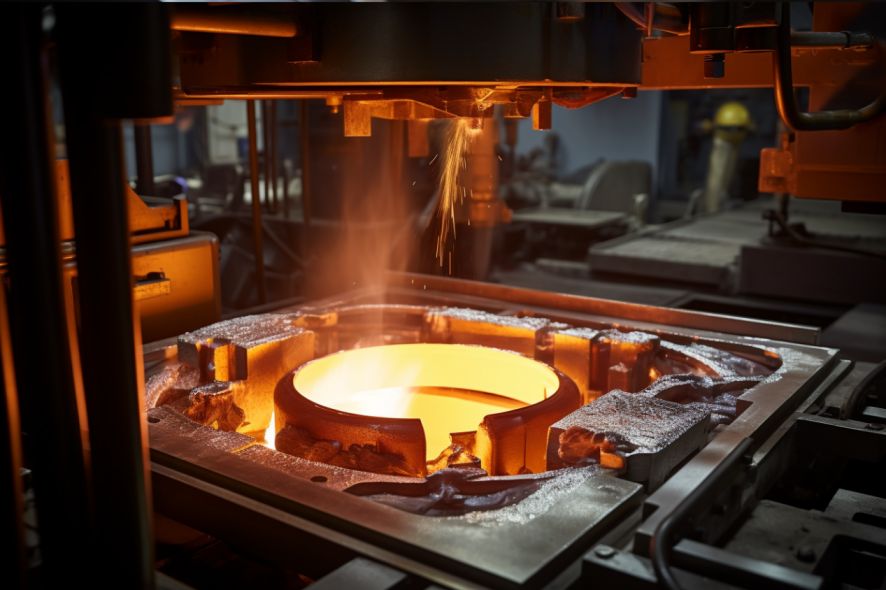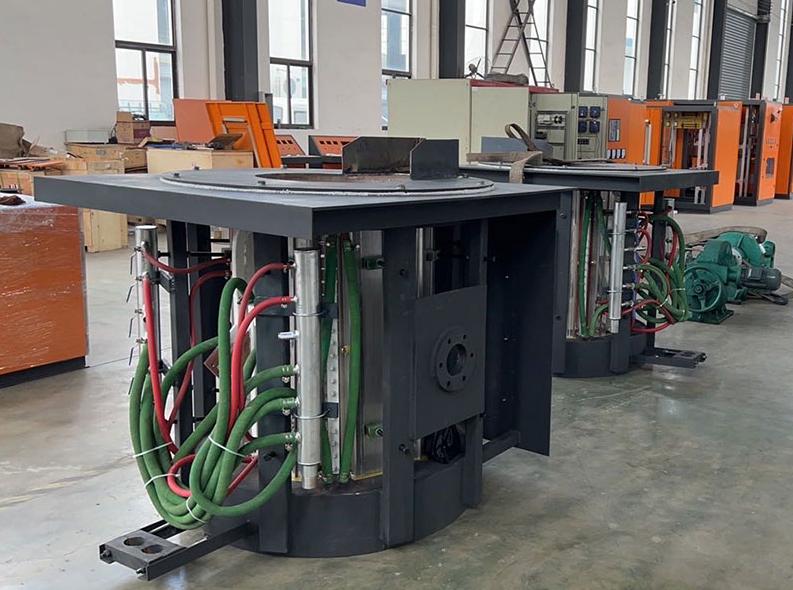Unleashing Precision: Harnessing the Power of Medium Frequency Induction Furnace in Metal Fabrication
Medium frequency induction furnaces are vital tools in the realm of metalworking, renowned for their efficiency, precision, and versatility. These furnaces leverage the principles of electromagnetic induction to generate intense heat, making them indispensable in various industries worldwide.
Introduction to Medium Frequency Induction Furnace
1.1 Overview of Medium Frequency Induction Furnace
Medium frequency induction furnaces operate on the principle of electromagnetic induction, where an alternating current passes through a copper coil, creating a rapidly alternating magnetic field. This magnetic field induces eddy currents within the conductive material placed inside the coil, generating heat through resistance. Unlike traditional furnaces that rely on direct flame or electrical resistance, medium frequency induction furnaces offer more controlled and uniform heating, making them ideal for melting and processing metals and alloys.
1.2 How They Work: Electromagnetic Induction Principles
At the heart of a medium frequency induction furnace lies the induction coil, a crucial component responsible for generating the magnetic field necessary for heating. The design of the coil, including its shape, size, and number of turns, influences the efficiency and performance of the furnace.
1.3 Applications and Industries Where They Are Commonly Used
Medium frequency induction furnaces find widespread use across various industries, including foundries, metal casting, automotive, aerospace, and metallurgical research. They are particularly favored for their ability to melt and process a wide range of metals and alloys, including steel, iron, copper, aluminum, and precious metals like gold and silver.
1.4 Advantages Compared to Other Types of Furnaces
Compared to traditional furnaces, medium frequency induction furnaces offer several advantages. They provide faster heating rates, precise temperature control, and uniform heating throughout the material. Additionally, they produce fewer harmful emissions and require less energy, resulting in lower operating costs and reduced environmental impact.
1.5 Brief History and Development of Medium Frequency Induction Furnace Technology
The development of medium frequency induction furnace technology dates back to the early 20th century when researchers began exploring ways to improve the efficiency of induction heating processes. Over the years, advancements in materials, electronics, and design have led to the refinement of induction furnace technology, paving the way for the widespread adoption of medium frequency induction furnaces in modern industrial applications.
Key Components of Medium Frequency Induction Furnaces
2.1 Induction Coil and Its Design Considerations
The design of the induction coil is critical to the performance of a medium frequency induction furnace. Factors such as coil geometry, material composition, and cooling methods must be carefully considered to optimize heat transfer and minimize energy losses.
2.2 Power Supply Unit: Frequency Converters and Inverters
Medium frequency induction furnaces rely on sophisticated power supply units equipped with frequency converters and inverters to regulate the frequency and voltage of the electrical input. These components ensure stable and efficient operation of the furnace, allowing for precise control of the heating process.
2.3 Crucibles and Lining Materials
Crucibles and lining materials play a crucial role in protecting the induction coil and containing the molten metal during the heating process. Materials such as refractory ceramics and graphite are commonly used due to their high heat resistance and thermal conductivity.
2.4 Cooling Systems for Maintaining Optimal Operating Temperatures
To prevent overheating and ensure continuous operation, medium frequency induction furnaces are equipped with cooling systems that dissipate excess heat generated during the heating process. Water-based cooling systems, including water jackets and cooling coils, are commonly employed to maintain optimal operating temperatures.
2.5 Safety Features and Protective Measures
Safety is paramount in industrial settings where medium frequency induction furnaces are employed. These furnaces are equipped with various safety features, including temperature sensors, emergency stop buttons, and interlocking mechanisms, to mitigate the risk of accidents and ensure the well-being of operators.
Operating Principles and Process of Medium Frequency Induction Furnaces
3.1 Heating Process: How Medium Frequency Induction Furnaces Generate Heat
Medium frequency induction furnaces generate heat through electromagnetic induction, wherein an alternating current induces eddy currents within the conductive material, resulting in resistive heating. This process allows for precise control of the heating rate and temperature, facilitating efficient melting and processing of metals and alloys.
3.2 Melting Various Types of Metals and Alloys
Medium frequency induction furnaces are capable of melting a wide range of metals and alloys, including ferrous and non-ferrous materials. From steel and iron to copper, aluminum, and beyond, these furnaces offer versatility and flexibility in metal processing applications.
3.3 Control Systems and Parameters for Temperature Regulation
Temperature regulation is essential for achieving desired metallurgical properties and product quality. Medium frequency induction furnaces are equipped with advanced control systems that monitor and adjust various parameters, including power input, frequency, and cooling rate, to maintain precise temperature control throughout the heating process.
3.4 Alloying and Refining Processes
In addition to melting metals, medium frequency induction furnaces are utilized for alloying and refining processes. By precisely controlling the composition and temperature of the melt, manufacturers can create custom alloys with specific properties tailored to their intended applications.
3.5 Efficiency Considerations and Energy Consumption
Efficiency is a key consideration in industrial processes, and medium frequency induction furnaces excel in this regard. Their rapid heating rates, uniform heating distribution, and energy-efficient operation contribute to higher productivity and lower operating costs compared to traditional heating methods.
Applications of Medium Frequency Induction Furnaces in Metalworking
Medium frequency induction furnaces are indispensable tools in the realm of metalworking, offering a wide array of applications across various industries. From casting and molding to heat treatment processes and recycling, these furnaces play a crucial role in shaping and processing metals and alloys with precision and efficiency.
4.1 Casting and Molding Applications
In the casting and molding industry, medium frequency induction furnaces are used to melt metals and alloys quickly and uniformly, facilitating the production of high-quality castings with intricate designs and precise dimensions. Whether it’s automotive parts, aerospace components, or decorative objects, these furnaces enable manufacturers to create complex shapes and structures with ease.
4.2 Metal Melting for Foundries and Metallurgical Industries
Foundries and metallurgical industries rely on medium frequency induction furnaces for melting and refining metals and alloys of various compositions. From ferrous metals like steel and iron to non-ferrous materials such as copper, aluminum, and zinc, these furnaces offer versatility and flexibility in processing a wide range of raw materials.
4.3 Heat Treatment Processes such as Annealing, Tempering, and Quenching
Medium frequency induction furnaces are also used in heat treatment processes such as annealing, tempering, and quenching, where precise control of temperature and heating rate is essential to achieve desired metallurgical properties. Whether it’s enhancing the strength and toughness of steel or improving the hardness and wear resistance of metal components, these furnaces play a crucial role in achieving optimal heat treatment outcomes.
4.4 Recycling of Metal Scraps and Waste Materials
In the era of sustainable manufacturing, medium frequency induction furnaces are increasingly being utilized for the recycling of metal scraps and waste materials. By melting down scrap metal and alloys, these furnaces enable manufacturers to reclaim valuable resources and minimize waste, contributing to environmental sustainability and resource conservation.
4.5 Case Studies Highlighting Specific Industrial Applications
Several case studies demonstrate the diverse applications of medium frequency induction furnaces across different industries. From small-scale foundries to large-scale manufacturing facilities, these furnaces have been instrumental in improving productivity, quality, and cost-effectiveness in metalworking operations worldwide.
Advantages and Challenges of Medium Frequency Induction Furnaces
5.1 Advantages: Rapid Heating, Precise Temperature Control, Energy Efficiency
One of the primary advantages of medium frequency induction furnaces is their ability to heat materials rapidly and uniformly, resulting in shorter processing times and higher productivity. Additionally, these furnaces offer precise temperature control, allowing manufacturers to achieve consistent results with minimal variation. Furthermore, medium frequency induction furnaces are known for their energy efficiency, consuming less power compared to traditional heating methods, thereby reducing operating costs and environmental impact.
5.2 Challenges: Initial Investment Costs, Maintenance Requirements
Despite their numerous benefits, medium frequency induction furnaces pose some challenges, particularly in terms of initial investment costs and maintenance requirements. The upfront cost of purchasing and installing these furnaces can be significant, making them less accessible to small-scale manufacturers. Additionally, ongoing maintenance and repair costs can add up over time, requiring careful planning and budgeting to ensure the long-term viability of these investments.
5.3 Comparison with Other Types of Furnaces (e.g., Resistance, Arc Furnaces)
Compared to other types of furnaces such as resistance and arc furnaces, medium frequency induction furnaces offer several distinct advantages. Unlike resistance furnaces, which rely on electrical resistance to generate heat, induction furnaces offer faster heating rates and higher efficiency due to the direct transfer of energy through electromagnetic induction. Similarly, compared to arc furnaces, which utilize electric arcs to melt materials, medium frequency induction furnaces provide more precise temperature control and produce fewer harmful emissions, making them more environmentally friendly.
5.4 Environmental Considerations and Emissions Control
Environmental considerations are increasingly important in the manufacturing industry, and medium frequency induction furnaces are designed with emissions control and environmental sustainability in mind. By minimizing energy consumption and reducing emissions of greenhouse gases and pollutants, these furnaces help manufacturers meet regulatory requirements and achieve their sustainability goals while maintaining high levels of productivity and efficiency.
Conclusion
In conclusion, medium frequency induction furnaces represent a pinnacle of modern industrial heating technology. With their unparalleled efficiency, precision, and versatility, they have become indispensable tools in metalworking and manufacturing processes across diverse industries. As technology continues to evolve, medium frequency induction furnaces are poised to play an even greater role in shaping the future of metallurgy and materials science.


